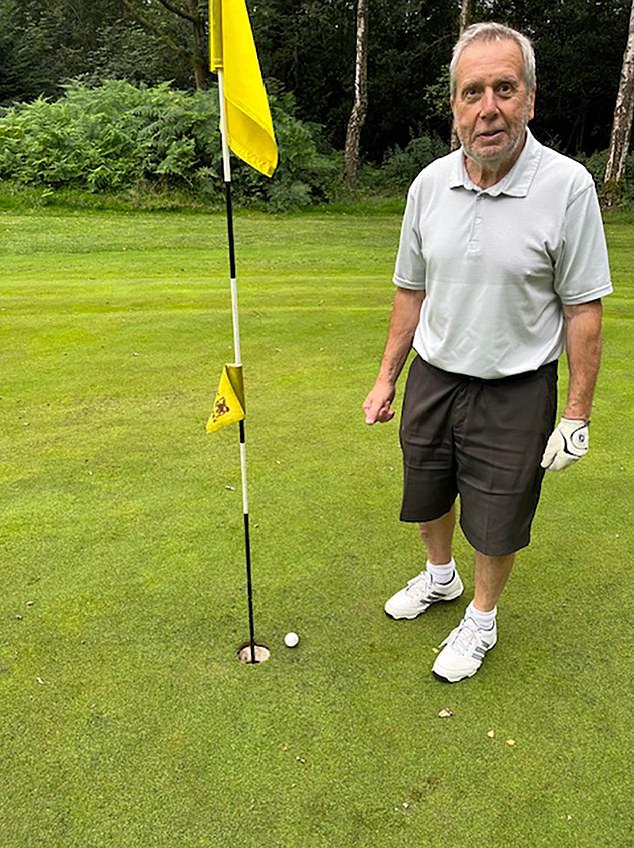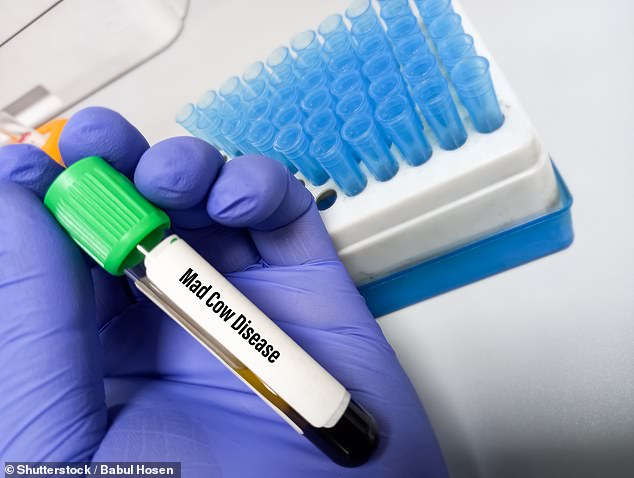Bob Deller was a healthy, fit grandfather who spent his time gardening, playing golf and practicing yoga when last summer he developed a persistent headache and started feeling dizzy.
His GP initially told him it was vertigo, a common condition that affects balance and usually improves on its own.
But it was the start of a rapid deterioration that quickly robbed the 75-year-old of his ability to talk and walk, and led to his death just four months later.
Shortly before Bob died in December, doctors discovered that the enthusiastic drummer was suffering from the “one in a million” fatal brain disease, Creutzfeldt-Jakob disease (CJD).
“When he first complained of headaches and dizziness I didn’t worry too much because the GP said he would get better,” says his widow Maggie, 75, a retired nurse who lives near Sevenoaks, Kent.

Bob Deller, pictured, was a healthy grandfather who spent his time playing golf, gardening and practicing yoga before he started feeling dizzy last summer.
‘He had always cared about his health, so he was very active. He walked our dogs for two hours every day, he never smoked or drank alcohol. But he went downhill so fast that he was so shocking. Within a few weeks he started shuffling when he walked, slurred his words, and became increasingly confused.’
To many, CJD is best known as the human form of so-called “mad cow” disease, which rose to prominence in the 1990s.
But the neurological disease comes in four types, only one of which, called variant CJD, is associated with the consumption of infected beef. Bob, a retired procurement officer, had a version called spontaneous CJD, which affects around 130 people a year in the UK and the cause of which is unknown.
In CJD, a common protein called a prion, which is found on the surface of brain cells and is thought to carry messages between them, malfunctions.
This appears to start a cascade that causes other prion proteins to malfunction, leading to brain cell death. The disease causes holes to develop in the brain, triggering mental degeneration and ultimately death. It is not known what prompts this process to begin in spontaneous CJD, which on average leads to death four months after symptoms begin.


A blood sample to check for Creutzfeldt-Jakob disease. There are no treatment options for the disease.
When Bob began to deteriorate, Maggie made an appointment with a private neurologist. “When we first went to see him in August, Bob used a cane,” says Maggie, who was married to Bob for 47 years.
‘The neurologist said it was definitely not vertigo and ordered an MRI.
‘When we went to get the results a month later, Bob was in a wheelchair. You could see how he was getting worse almost day by day.”
Along with the growing confusion, Bob’s arms and legs began to shake violently. Doctors performed many scans and tests trying to discover what was behind the rapid decline of Bob, who was the stepfather of Maggie’s son, Kevin. Alzheimer’s disease, Parkinson’s disease and a brain tumor were ruled out.
After a fall at home in November, Bob went to the hospital where a special type of MRI with contrast dye showed changes in parts of his brain that were suggestive of CJD.
Experts from the National CJD Surveillance and Research Unit at the University of Edinburgh analyzed fluid taken from his spine to confirm he had the condition in November.
“We spoke to a specialist before the cerebrospinal fluid test and he told us that if it was CJD he would die within a month, which was obviously shocking for Kevin and me,” says Maggie.
“After Bob went into the hospital, he couldn’t talk anymore,” she says. “He didn’t really give any sign that he was aware we were there, but he did seem to smile when his two grandsons came to see him.” Bob died in hospital shortly before Christmas.
“He was very unlucky to get such a rare disease,” says Maggie. ‘The doctors at the hospital had never seen him before. We miss him very much, he was always interested in knowing what the grandchildren were up to and he was witty and funny. He loved jazz and soul and it was always playing in the background, the house is silent without his music.’
There are no treatment options for CJD, which can progress surprisingly quickly, says Richard Knight, professor of clinical neurology at the National CJD Research and Surveillance Unit.
“The progression of spontaneous CJD can be quite astonishing and surprising to families and doctors, as they are not used to it,” he says. “Families tell us that their relative was able to walk when they were admitted to the hospital, and when they talk to us two days later, they can’t walk or talk.”
There are only two risk factors that have been confirmed. One is aging, with people under 40 rarely developing the disease, and the other is a particular version of a gene carried by a third of the population.
UK population, says Professor Knight. Rates are slowly increasing around the world, but this is most likely due to improvements in diagnosis, he says.
Research is looking at some promising areas that could address the disease, but the speed of its progression through the brain and the relatively late time at which people are diagnosed will likely make trials difficult, he adds.
“There is nothing you can do to reduce the risk of developing spontaneous CJD,” says Professor Knight. “But it is rare – one or two people in every million die from this disease each year in the UK.”
